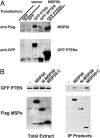Cellular transformation by the MSP58 oncogene is inhibited by its physical interaction with the PTEN tumor suppressor
- PMID: 15659546
- PMCID: PMC549467
- DOI: 10.1073/pnas.0409370102
Cellular transformation by the MSP58 oncogene is inhibited by its physical interaction with the PTEN tumor suppressor
Abstract
The PTEN (phosphatase and tensin homologue) tumor suppressor protein contains a single catalytic domain with both lipid and protein phosphatase activities. The remaining C-terminal half of the PTEN protein plays a role in its stability and is mutated in many clinical cancer samples. Here, we report that the PTEN C-terminal domain physically interacts with the forkhead-associated domain of the oncogenic MSP58 protein and that this interaction requires PTEN Thr-366. We further show that while MSP58 transforms Pten-/- mouse embryo fibroblasts (MEFs), concurrent introduction of wild-type PTEN causes a dramatic reduction in the number of MSP58-induced transformed foci. This PTEN-mediated inhibition of cellular transformation requires physical interaction as evidenced by the failure of PTEN(T366A) point mutation (residing within the MSP58 interaction domain) to suppress MSP-58-driven transformation. These observations, together with the capacity of catalytically inactive PTEN mutant (G129R) to suppress MSP58 oncogenicity, support the view that the C-terminal region of PTEN directly provides a previously uncharacterized biological function in its ability to regulate cellular transformation.
Figures




Comment in
-
Phosphatase and tensin homologue growth suppression without phosphatase.Proc Natl Acad Sci U S A. 2005 Feb 22;102(8):2677-8. doi: 10.1073/pnas.0500089102. Epub 2005 Feb 14. Proc Natl Acad Sci U S A. 2005. PMID: 15710873 Free PMC article. No abstract available.
Similar articles
-
Phosphatase and tensin homologue growth suppression without phosphatase.Proc Natl Acad Sci U S A. 2005 Feb 22;102(8):2677-8. doi: 10.1073/pnas.0500089102. Epub 2005 Feb 14. Proc Natl Acad Sci U S A. 2005. PMID: 15710873 Free PMC article. No abstract available.
-
PTEN: a novel anti-oncogenic function independent of phosphatase activity.Cell Cycle. 2005 Apr;4(4):540-2. doi: 10.4161/cc.4.4.1614. Epub 2005 Apr 21. Cell Cycle. 2005. PMID: 15753657 Review.
-
An essential role for protein synthesis in oncogenic cellular transformation.Oncogene. 2004 Apr 19;23(18):3145-50. doi: 10.1038/sj.onc.1207550. Oncogene. 2004. PMID: 15094764 Review.
-
Pten signaling in gliomas.Neuro Oncol. 2002 Jul;4(3):196-211. Neuro Oncol. 2002. PMID: 12084351 Free PMC article. Review.
-
Regulation of cell migration by the C2 domain of the tumor suppressor PTEN.Science. 2004 Feb 20;303(5661):1179-81. doi: 10.1126/science.1092089. Science. 2004. PMID: 14976311
Cited by
-
Loss of PTEN expression is associated with colorectal cancer liver metastasis and poor patient survival.BMC Gastroenterol. 2008 Nov 26;8:56. doi: 10.1186/1471-230X-8-56. BMC Gastroenterol. 2008. PMID: 19036165 Free PMC article.
-
Inhibition of the phosphatase PTEN protects mice against oleic acid-induced acute lung injury.Br J Pharmacol. 2009 Jan;156(1):189-200. doi: 10.1111/j.1476-5381.2008.00020.x. Br J Pharmacol. 2009. PMID: 19134000 Free PMC article.
-
Tumor suppression by PTEN requires the activation of the PKR-eIF2alpha phosphorylation pathway.Sci Signal. 2009 Dec 22;2(102):ra85. doi: 10.1126/scisignal.2000389. Sci Signal. 2009. PMID: 20029030 Free PMC article.
-
Expression of MSP58 in human colorectal cancer and its correlation with prognosis.Med Oncol. 2012 Dec;29(5):3136-42. doi: 10.1007/s12032-012-0284-y. Epub 2012 Jul 8. Med Oncol. 2012. PMID: 22773039 Free PMC article.
-
The impact of phosphorylated PTEN at threonine 366 on cortical connectivity and behaviour.Brain. 2022 Oct 21;145(10):3608-3621. doi: 10.1093/brain/awac188. Brain. 2022. PMID: 35603900 Free PMC article.
References
-
- Maehama, T., Taylor, G. S. & Dixon, J. E. (2001) Annu. Rev. Biochem. 70, 247–279. - PubMed
-
- Eng, C. (2003) Hum. Mutat. 22, 183–198. - PubMed
-
- Larsen, M., Tremblay, M. L. & Yamada, K. M. (2003) Nat. Rev. Mol. Cell Biol. 4, 700–711. - PubMed
-
- Lee, J. O., Yang, H., Georgescu, M. M., Di Cristofano, A., Maehama, T., Shi, Y., Dixon, J. E., Pandolfi, P. & Pavletich, N. P. (1999) Cell 99, 323–334. - PubMed
Publication types
MeSH terms
Substances
Grants and funding
LinkOut - more resources
Full Text Sources
Research Materials

